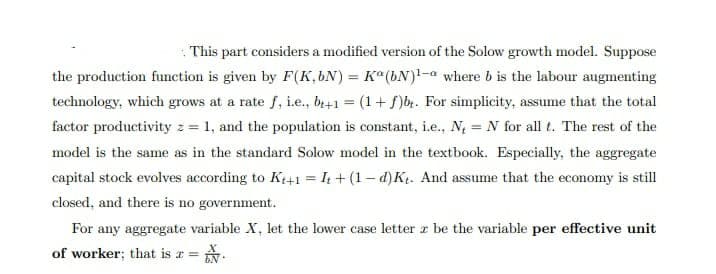List all the equilibrium conditions of this model and Using the equilibrium conditions listed, write down an expression that describes the evolution of the aggregate capital stock, Kt over time. Briefly explain why this expression is not particularly convenient for our analysis of the model? b.Using your answer to the above question, derive the equation that describes the evo- lution of the the capital stock per effective unit of worker, kt. ' Why is the analysis in terms of the variables per effective unit of worker more useful than the one with the aggregate capital stock? c. Assume that a E (0, 1). Draw a diagram that describes the evolution of kt, and show that there exists a unique steady state, k* > 0. Label properly. Find the expressions for the steady state variables k*, y*, and c* in terms of the parameters of the model. , Now, assume that α = 1. Draw a diagram that describes the evolution of kt, and show that income per worker can grow indefinitely in this case. Label properly.
a. List all the equilibrium conditions of this model and Using the equilibrium conditions listed, write down an expression that describes the evolution of the aggregate capital stock, Kt over time. Briefly explain why this expression is not particularly convenient for our analysis of the model?
b.Using your answer to the above question, derive the equation that describes the evo- lution of the the capital stock per effective unit of worker, kt. ' Why is the analysis in terms of the variables per effective unit of worker more useful than the one with the aggregate capital stock?
c. Assume that a E (0, 1).
Draw a diagram that describes the evolution of kt, and show that there exists a unique steady state, k* > 0. Label properly. Find the expressions for the steady state variables k*, y*, and c* in terms of the parameters of the model. , Now, assume that α = 1. Draw a diagram that describes the evolution of kt, and show that income per worker can grow indefinitely in this case. Label properly.

Step by step
Solved in 2 steps









